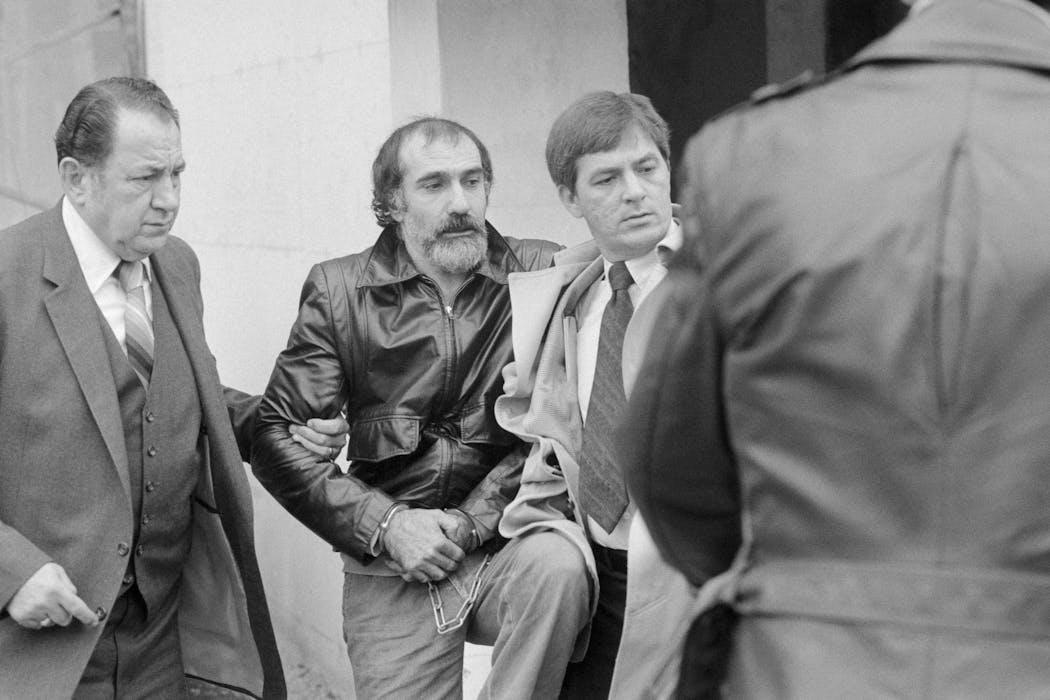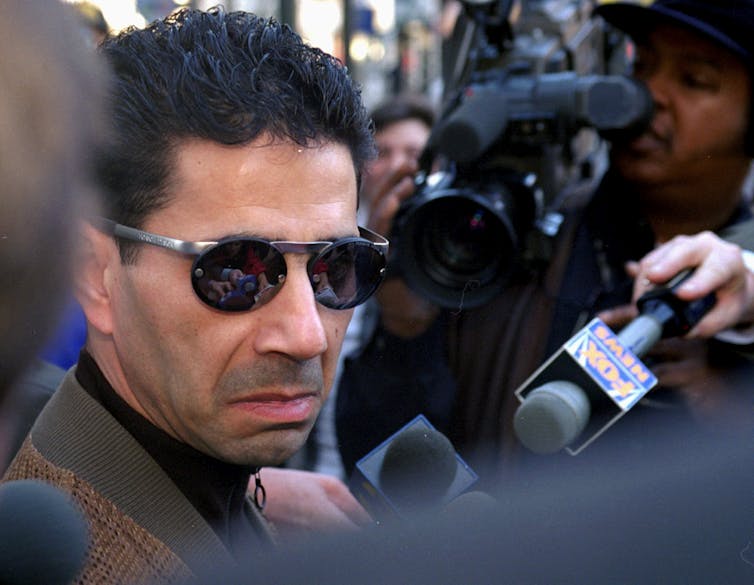How mobsters’ own words brought down Philly’s mafia − a veteran crime reporter has the story behind the end of the ‘Mob War’
- The FBI’s electronic surveillance operation played a crucial role in bringing down the Philadelphia mafia, also known as the “Mob War”, by capturing incriminating conversations between mobsters.
- The war was fought between two factions of the Philadelphia mob, led by John Stanfa and Joseph “Skinny Joey” Merlino, over control of illegal operations such as gambling, loan-sharking, and extortion.
- Over 2,000 conversations were recorded during the two-year electronic surveillance operation, which was made possible through court authorization to plant listening devices in law offices and other locations.
- The recordings proved to be a treasure trove for investigators and journalists, providing details about the war and offering insights into the world of organized crime that rivaled fictionalized stories like “The Godfather” or “The Sopranos”.
- The use of electronic surveillance in racketeering trials led to the conviction and imprisonment of many mobsters, including Stanfa, who is currently serving a life sentence, and Merlino, who received a sentence ranging from 7 to 14 years.

Bettmann via Getty Images
The bloody mob war that is the focus of the new Netflix series “Mob War: Philadelphia vs. The Mafia,” which premieres Oct. 22, 2025, is full of the murder and mayhem, treachery and deceit that have been the hallmarks of the nation’s Cosa Nostra family conflicts.
What was different in Philadelphia was that the FBI had it all wired for sound.
Electronic surveillance has been a major tool in the government’s highly successful war against the Mafia nationwide, but nowhere has its impact been felt more dramatically than in Philadelphia.
As a reporter for The Philadelphia Inquirer, I covered this mob war in real time from 1994 through 2000. Now I teach a course at Rowan University on the history of organized crime, using the war as a case study, and I was a consultant on the Netflix series.
The war pitted one faction of the Philadelphia mob, headed by Sicilian-born John Stanfa, against a rival faction led by Joseph “Skinny Joey” Merlino. The issues were control of all illegal operations in the underworld – gambling, loan-sharking, drug-dealing and extortion. Money was the bottom line, but there also was a cultural and generational divide that had Stanfa and, for the most part, his group of older wiseguys facing off against Merlino and his crew of young South Philadelphia-born mobsters.
But only after indictments were handed down and evidence was introduced at trials did the extent of the electronic surveillance operation become known.
‘Goodfellas kill goodfellas’
Mobsters, speaking in unguarded moments and unaware that the feds were listening, buried themselves.
So here was mob boss Stanfa discussing with an associate plans to lure Merlino and two of his two lieutenants to a meeting where they would be killed:
“See, you no gotta give a chance,” the Sicilian-born Stanfa said in his halting English. “Bam, bam … Over here is best, behind the ear.”
Or here was Salvatore Profaci, a New York mobster brought in to quietly settle a dispute that had gone public after mob lawyer Salvatore Avena filed a multimillion-dollar lawsuit against his mobbed-up business partner in a trash-hauling business.
“Goodfellas don’t sue goodfellas,” Profaci said in a line that couldn’t have been written any better by “The Godfather” author Mario Puzo or delivered more effectively by the award-winning actor Robert De Niro. “Goodfellas kill goodfellas.”
The most staggering piece of the investigation, which was made known only after Stanfa and more than 20 of his associates had been indicted and arrested, was that the FBI had received court authorization to plant listening devices in the Camden, New Jersey, law offices of Salvatore Avena, Stanfa’s defense attorney.
A judge approved the highly unusual authorization after the feds argued that Stanfa was using the shield of attorney-client privilege to conduct mob meetings in Avena’s office while a mob war raged on the streets of South Philadelphia.
More than 2,000 conversations were recorded during the two-year electronic surveillance operation, with FBI agents and an assistant U.S. attorney manning a listening post in the basement of the federal courthouse a block away from Avena’s office. Whenever Stanfa and his associates got together, the feds were listening. Many of those conversations were then introduced as evidence at the racketeering trials that followed.
The conversations proved to be a treasure trove not only for investigators but also for journalists who covered the story as it unfolded and later got access to the tapes that were made public when the cases went to trial.
Blood in the streets
Two of the books I’ve written about the Philadelphia mob, “The Last Gangster” in 2004 and “The Goodfella Tapes” in 1998, are built around those tapes and the investigations they spawned.
Anyone who has written true crime knows that part of the problem with nonfiction storytelling is coming up with dialogue. In writing books about the Philadelphia mob wars that are the focus of the new Netflix series, that was never a problem.
Mobsters from Philadelphia, South Jersey, New York and the Scanton-Wilkes Barre area of Pennsylvania ended up on the recordings, which offered not only details about the war but also included philosophical ramblings and personal asides that provided a glimpse into the world of organized crime as good as or better than any fictionalized story line from “The Godfather” or “The Sopranos.”
Throughout the conflict, as bodies piled up and blood ran in the streets of the City of Brotherly Love, Stanfa and several of his associates were picked up plotting murder and mayhem, bemoaning the loss of honor and loyalty that had once been the hallmark of Cosa Nostra, and belittling their street-corner rivals, the “little Americans” who hadn’t a clue about what it meant to be a real mafioso.
“When you’re a dwarf they could put you on a high mountain, you’re still a dwarf,” Avena told Stanfa in one of several conversations mocking Merlino and his associates.
“I was born and raised in this thing (Cosa Nostra) and I’m gonna die in this thing,” said Stanfa at another point, bemoaning the state of the Philadelphia mob. “But with the right people. Over here is like kindergarten.”

AP Photo/H. Rumph Jr.
‘You can’t cross-examine a tape’
Electronic surveillance was used again and again in racketeering trials in which the feds not only dismantled but judicially eviscerated the Philadelphia crime family.
Stanfa is currently serving life in prison. Several of his top associates were jailed for more than 20 years. In a second prosecution, Merlino and most of his top associates were convicted of racketeering and jailed for sentences ranging from seven to 14 years.
Dozens of conversations were played for the juries that sat in judgment during the racketeering trials that followed. Again and again the mobster’s own words were turned against them.
Another highlight was an FBI surveillance video of a mob hit picked up on a hidden camera as it occurred. A surveillance camera located across the street from a deli run by then-Stanfa underboss Joseph Ciancaglini Jr. picked up the early morning shooting in which four shadowy figures burst into the deli and opened fire. An audio bug hidden inside the deli provided the sound effects – gunshots, shouting and the screams of a waitress. The shooting occurred shortly after 6 a.m. and just moments after Ciancaglini and his waitress had arrived and begun setting up for business.
Cooperating witnesses were also part of the trial, but defense attorneys frequently undermined their testimony by providing a litany of the crimes – often including murders – that the witnesses had admitted to as part of their plea deals.
You can attack the credibility of a cooperating witness by focusing on his own crimes and his need to say whatever the government wants in order to win a lenient sentence, a defense attorney once explained to me. What you can’t do, he said, “is cross-examine a tape.”
Jurors got to hear mobsters in their own words discussing the mob war. And there was nothing the defense could do to counterattack the impact of those words.
One classic discussion underscored the mobsters’ concern about electronic surveillance and demonstrated their inability to do much about it.
Stanfa consigliere Anthony Piccolo was talking with Avena about the problem with cooperators and phone taps. Both men agreed it was important to be cautious. Avena then told Piccolo that he’d had an electronic anti-bugging expert come into his office over the weekend and had swept the rooms. It had cost him $500, Avena said.
“It’s money well spent,” said Piccolo as the undetected FBI listening device beamed the conversation back to the listening post.
Read more of our stories about Philadelphia and Pennsylvania, or sign up for our Philadelphia newsletter on Substack.
![]()
George Anastasia is the owner of G&A Media LLC, the company through which he served as consultant for the series and through which he was paid, .
